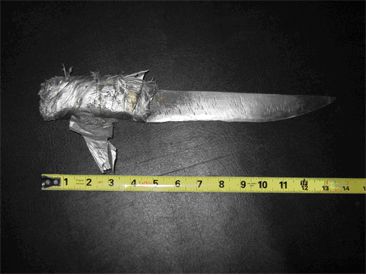|
|
| Contraband Corner |
| By Joe Bouchard |
| Published: 06/22/2015 |
 The following is an installment in "The Bouchard 101", a series featuring "Ice Breaker's" designed to promote training awareness and capabilities in the corrections industry.
The following is an installment in "The Bouchard 101", a series featuring "Ice Breaker's" designed to promote training awareness and capabilities in the corrections industry.
“Would anyone care for a mint? I will pass this tin around. Please, take one!” What could be more disarming than a trainer officer distributing breath mints or candy to an audience? It is a welcoming gesture and a way to suppress coughs. But can it serve as a doorway into the nefarious art of shank making. To start the contraband corner icebreaker, instructors will need:
(from page 1 of Wake up and smell the contraband: A Guide to Improving Prison Safety. (2nd edition) Horsham PA: LRP Publications, 2005, by Joseph Bouchard.) Once you have given students the conceptual framework of the problem, make it more tangible. Hand out the scenario and read aloud. “One of your co-workers is a hazard. You believe that no one can be so negligent by accident. Over the years, he has misplaced many items in his office: lighters, local tourist maps, transfer bulletins, and his personal cell phone. He once left his work keys on the counter while prisoners were in the building. One time, he left his office door open and was conducting personal business on the telephone. He gave his home telephone number over the phone as well as one of his credit card numbers - and within earshot of the prisoners in his area of control. Despite warnings and discipline, his reign of dangerous mistakes continue. Today, he asks you why you stole his breath mints from his desk. (That is another of what many consider to be his flaws: He never takes responsibility for his lack of security and is abrasive and accusatory.) Explaining that you did not take his mints, you offer to help search for them. You ask for a description. “You know,” he snarls in a tone of impatience, “they are such and such brand – the kind in the little metal box about two inches by three inches!” “He has topped himself in idiocy,” you think to yourself. “Some one will get hurt because of him.!” You know that there is very likely a dangerous and pliable fist full of metal floating around the facility. Of course, you call control center and expect that there will be another facility shakedown originating from this colleague’s negligence. During the search, you think in terms of how that object could be fashioned into a weapon. You imagine how easy it would be to create a weapon from that mint box. Your blood chills as you ponder the possibilities…” Divide the audience into groups of four. Tell participants that they represent a group of prisoners who obtained the small, metal container from the negligent staff member. Someone managed to get it to the housing unit, through the shakedowns, without detection by staff. Give one sock and one small metal container of mints to each group of four. Tell them to make a weapon out of the sock and the very bendable metal. Here are the rules:
When the fifteen minutes have expired, each group will explain the methodology and results of the exercise. Notice different ways that the same material can be fashioned into contraband of different dimensions. You can even open discussion of how each weapon could specifically be used to hurt staff. Flip charts can be used to help illustrate methods. Then, pass your version of the weapon around. Of course, as a trainer, you have the advantage of more time and thought for your weapon. I was able, for example, to make an ordinary mint tin and sock into a two-bladed fist knife. (See photo.) Note that the center of the weapon is bound in a shredded sock for a better grip. You can lead your audience in a discussion about the merits and flaws of each weapon. With the flip chart, you can also conduct a quick contraband control survey. Solicit a volunteer to record answers on the flip chart while you ask the students these questions:
We cannot forget that there are many cautions to this icebreaker:
Joe Bouchard is a Librarian employed with the Michigan Department of Corrections and a collaborator with The International Association of Correctional Training Personnel (IACTP). He is also the author of “IACTP’s Corrections Icebreakers: The Bouchard 101, 2014”. The installments in this series include his opinions. The agency for which he works is not in any way responsible for the content or accuracy of this material, and the views are those of the contributor and not necessarily those of the agency. While some material is influenced by other works, all of the icebreakers have been developed by Joe Bouchard. Visit the Joe Bouchard page Other articles by Bouchard: |
MARKETPLACE search vendors | advanced search

IN CASE YOU MISSED IT
|


Comments:
No comments have been posted for this article.
Login to let us know what you think